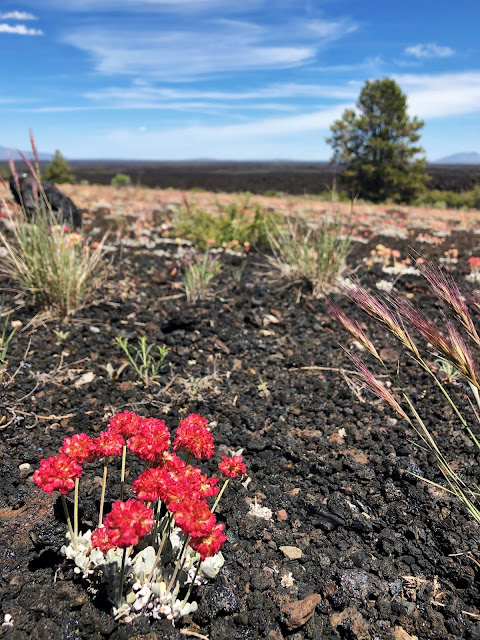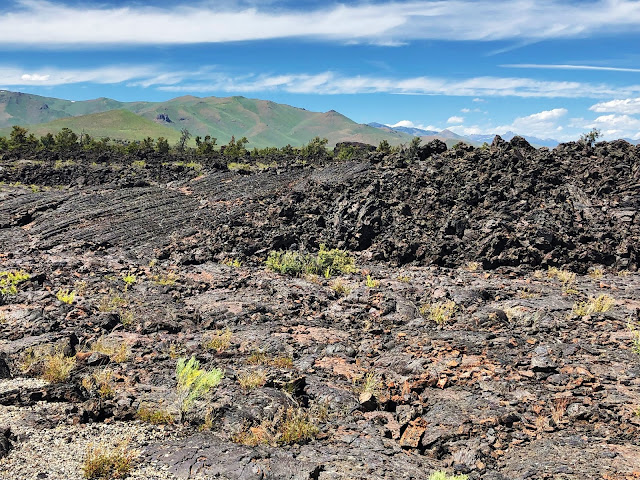Joe T. Fallini BLM CG
Before we make the hour drive from the campground to visit Craters of the Moon National Monument, we made a planned stop at Arco as we drove through. There is a submarine memorial we wanted to visit.
This site on the side of the highway is manned by very enthusiastic veterans with so much information to share. We spent about an hour here while they told us all about the submarine and the atomic history of the area. The gentleman we toured with was a submarine vet. He had some great stories to share with us.
USS Hawkbill (SSN-666) was a nuclear-powered submarine and was sometimes called "The Devil Boat" or the "Devilfish" because of her hull number (666). There is reference to a chapter 13 in the Bible which begins "And I stood upon the sand of the sea, and saw a beast rise up out of the sea...."
The tiny building above is the museum. It is packed with artifacts, pictures and history.
DIVE DIVE DIVE!!!
(turn up the speakers :-)
A waste shipment container. Bonus, there was a geocache hidden behind it.
Behind the exhibit you can't miss what first appears as graffiti up in the hills. It is a tradition in Arco called the “Number Hill”. For decades, the high school senior class has been decorating the nearest mountain with the last two digits of their graduation year.

If you look closely you can see the numbers painted on the mountainside.

Arco was chosen for the atomic experiment because of its remote and sparsely-populated area. The only fatal nuclear accident occurred in Arco in 1961. There was a core meltdown in the National Reactor Testing Station which killed three servicemen.
Arco was the first community in the world to be lit by electricity generated solely by nuclear power. This occurred for about an hour on July 17, 1955. On January 3, 1961 a reactor was destroyed through an operator maintenance error causing a steam explosion which resulted in the deaths of all three personnel present. It was the world's first and the United States only fatal reactor accident Thirty miles to the south is Atomic City with a population of 29. It was home to the Experimental Breeder Reactor I (EBR-I), and decommissioned in 1964. Today it's designated as a National Historic Landmark where the world’s first atomic-powered electricity was generated.
Steve and I have been to Craters of the Moon a couple of times over the years, but my brother has not been back since we were kids and his wife had never visited. It's a very interesting place and worth a visit if you've never been.
First you'll begin to see lava fields. Due to the plentiful rains, it was still very green out. The weather can be very drastic here. In winter there can be over 2 feet of snow and in summer the 90s can create temperatures of 170 degrees on the surface of the lava. It is usually windy too.

1805: Lewis and Clark cross northern Idaho enroute to the Pacific Ocean.
1862: Tim Goodale leads 1,095 emigrants and 338 wagons across a cutoff of the Oregon Trail that came to bear his name.
1924: President Calvin Coolidge signs a proclamation creating Craters of the Moon National Monument.
1927: Waterholes that supplied water to the monument dried up following a series of earthquakes and water had to be hauled in for four years.
1969: NASA astronauts Alan Shepherd, Edgar Mitchell, Eugene Cernan, and Joe Engle explore the monument while training to visit the moon.
196:3 Mt. Borah earthquake with a magnitude of 6.9 felt at the monument but does little damage.
It's always been later in the summer when I've been here so it was nice to see wildflowers carpeting the lava with pretty blooms.
The famous lave hill you can climb for fantastic views.


There is a long walking path that will take you to several ice caves you can walk into.
The colors and patterns to the lava were beautiful. Some sharp as razors, others smooth.
It was a very busy day and we enjoyed our visit.
On the way back we admired the purple blooms in the fields as well.
We wrapped up the day with some play time in the lake with Hurley. Always a great way to end a day!











































Isn't is wonderful there? When we arrived at Craters of the Moon it snowed. The black lava was covered with white, which gave a whole new experience. Also, it was here I ended the journey of my little red underpants rock. :(
ReplyDeleteI re-read that rock story. How did it end though?
DeleteI am glad you got into the little park museum. It was closed when we were there.
ReplyDeleteIt was crammed full of info and artifacts! Nice stop!
DeleteWe almost went to Arco to see the solar eclipse a couple years ago. Now that I know about the memorial, we'll have to make a stop there one day. Ron, Jessica and I have been to Craters of the Moon. We walked through some of the lava tunnels and explored a bit. But it was summer and quite hot when we were there. Those flowers sure are adapted to surviving in a harsh environment. Hurley is such a water dog! :-)
ReplyDeleteSome really cool stuff there in Arco.
DeleteSuch a unique area out in the middle of no where. We loved Craters of the Moon. I could not imagine serving on a sub, way too confined for me!
ReplyDeleteMe either! Too cramped.
DeleteWe've never stopped at the museum, looks like we need to the next time we visit Craters of the Moon. We were there during a super bloom, so nice there was things blooming for your visit.
ReplyDeleteThe museum is nice and we're so happy we caught the end of the super bloom too.
ReplyDelete